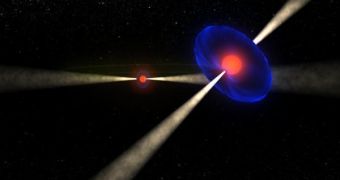By making observations on a binary system of pulsars a team of researchers from the McGill University in Montreal measured for the first time the spin precession of a celestial body located outside the solar system. Pulsars are a type of neutron stars with strong magnetic fields, emitting electromagnetic radiation through the poles. Most of the time they are found in systems, orbiting other companions and because they also have strong gravitational fields, pulsars can be used to test several of the predictions made by the Theory of General Relativity.
According to the Theory of General Relativity, gravitational fields can be imagined as warps in the fabric of space-time. As a body spins around its axis in these areas of warped space it is forced to wobble, thus the axis of rotation should describe a circle over a certain period of time. "This measurement is the first clear quantitative test of spin precession in a star or a body outside the solar system," says Rene Breton of McGill University, leader of the research team.
The binary system used in the study, J0737-3039, is composed of two pulsars, one of which has a spin axis that happens to be pointing exactly towards Earth. The second pulsar orbits around the first one every 2.5 hours, passing directly in front of it, thus eclipsing the lighthouse-like beam emitted through the poles of the orbited pulsar.
By observing the light from the eclipses, the research team was able to build a model from which they could extract the shape of the magnetic field of the orbited pulsar, which in turn revealed the orientation of its axis in relation to our position. After four years of observations, the team realized that the axis of the pulsar changed its position by 5 degrees each year, meaning that it would take 75 years for the axis to describe a complete circle.
Furthermore, the measurements appear to accurately fall within the predictions made by Einstein in his Theory of General Relativity. However, eventually, the precession of the pulsar could provide observations that may suggest deviations from Einstein's theory, such as one theory stating that objects with identical mass and different compositions may have different gravitational effects.
"Any way that we can continue to push at the limits of experimental verifications of general relativity is good because it may give us a clue as to how to unify the laws with the rest of theoretical physics," says Joseph Taylor of Princeton University, who won the Nobel Prize for his work on binary pulsars.
"It's very unique and we really don't expect it from other systems. I'd be better off buying a ticket for the lottery instead," said Breton, referring to the unique configuration of the J0737-3039, allowing the observation of precession through eclipses. First of all, a beam of light must be shining directly towards Earth and secondly another body must pass in front of the first to eclipse it through our line of sight.
The fate of the two pulsars is sealed. As they orbit each other, energy is lost in the form of gravitational waves allowing them to approach even closer to one another, until they collide to form a single object.

 14 DAY TRIAL //
14 DAY TRIAL //